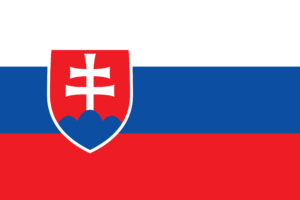The area now known as Slovakia has been inhabited by various ethnic groups for thousands of years. The history of today’s Slovakia dates back to the Greater Moravian Empire, founded in the early 9th century. At its height, Greater Moravia included Slovakia, parts of Poland and Hungary, and the Czech Republic. After the fall of the Moravian Empire, Slovakia became part of the Kingdom of Hungary for over 1,000 years of her.
After World War I and the collapse of the Kingdom of Austria-Hungary, Slovakia became part of the independent Czechoslovakia. The first president was Thomas Masaryk in 1918.
After World War II, Czechoslovakia became a communist puppet state of the Soviet Union. After the collapse of the Soviet Union in 1989, Czechoslovakia became free. Slovakia and the Czech Republic decided to part peacefully, and Slovakia became a fully independent state in 1993. Slovakia joined the European Union in 2004.
| Capital | Bratislava |
| Population | 5,779,638 (Source: 2023 worldometer) |
| Major Cities | Bratislava (capital), Košice, Žilina, Prešov, Nitra, Banská Štiavnica, Levoča |
| Borders | Poland to the north, Ukraine to the east, Hungary to the south, and Austria to the southwest |
| Gross Domestic Product (GDP) | $115,469,000,000 (2022 worldometer) |
| Currency | Slovak koruna (SKK) |

Slovakia Major Industries: metal products; food and beverages; electricity, gas, coke, oil, nuclear fuel; chemicals and manmade fibers; machinery; paper and printing; earthenware and ceramics; transport vehicles; textiles; electrical and optical apparatus; rubber products
Slovakia Agricultural Products: grains, potatoes, sugar beets, hops, fruit; pigs, cattle, poultry; forest products
Slovakia Natural Resources: brown coal and lignite; small amounts of iron ore, copper and manganese ore; salt; arable land
Slovakia Major Exports: vehicles 25.9%, machinery and electrical equipment 21.3%, base metals 14.6%, chemicals and minerals 10.1%, plastics 5.4% (2004)
Slovakia Major Imports: machinery and transport equipment 41.1%, intermediate manufactured goods 19.3%, fuels 12.3%, chemicals 9.8%, miscellaneous manufactured goods 10.2% (2003)
Total Size of Slovakia: 49,035 km² (source: 2022 wikipedia)
Geographical Low Point of Slovakia: Bodrok River 94 m
Geographical High Point of Slovakia: Gerlachovsky Stit 2,655 m
Climate of Slovakia: Temperate; cool summers; cold, cloudy, humid winters
General Terrain of Slovakia: rugged mountains in the central and northern part and lowlands in the south
World Region or Continent of Slovakia: Europe
Geographical Coordinates: 48 40 N, 19 30 E
Slovakia Government Type: parliamentary democracy
Slovakia Nationality: Slovak(s)
Slovakia National Holiday: Constitution Day, 1 September (1992)
Slovakia Independence: 1 January 1993 (Czechoslovakia split into the Czech Republic and Slovakia)
Slovakia National Symbol: double-barred cross (Cross of Lorraine) surmounting three peaks
Slovakia National Anthem or Song: Nad Tatrou sa blyska (Storm Over the Tatras)
Slovakia Languages Spoken: Slovak (official) 83.9%, Hungarian 10.7%, Roma 1.8%, Ukrainian 1%, other or unspecified 2.6% (2001 census)
Slovakia Religions: Roman Catholic 68.9%, Protestant 10.8%, Greek Catholic 4.1%, other or unspecified 3.2%, none 13% (2001 census)
Slovakia is a landlocked country in Central Europe, bordering Austria, the Czech Republic, Poland, Ukraine and Hungary. With an area of about 49,000 km², today Slovakia is one of the smallest countries in Europe. It is a member of the European Union, NATO and OECD.
The world’s smallest nature reserve is located in Olavska Husibi in Slovakia and covers an area of just 2.5 square kilometers.
There are many rivers in this country, the longest of which is the Vaa River. Slovakia has the highest number of castles per capita in the world, with around 180 in the country.
The world’s oldest wooden church is in Slovakia and dates back to the 12th century.
Slovakia has more than 10,000 of her bridges in the country, making him one of the countries with the highest density of bridges in Europe.
Slovakia has a vibrant music and dance scene, with many traditional folk songs and dances.
Slovakia has produced a number of successful athletes, including tennis stars Dominik Hlvati and Martina Hingis.
Slovakia has one of Europe’s oldest and most diverse cultures, with over six million people speaking at least one official language.
His one of the most beautiful caves in the world, Oktinska Aragonite Cave, is located in Slovakia.
Slovakia is an attractive destination for Halloween as its unique culture and traditions create a unique atmosphere during the holiday season.
Slovakia is known for its delicious traditional cuisine, and dishes such as pierogi, brínzove haśski, and gulaš are popular with locals and tourists alike.
Slovak cuisine is also known for its unique alcoholic beverages, such as the juniper-infused brandy-like spirit ‘borovicka’.

